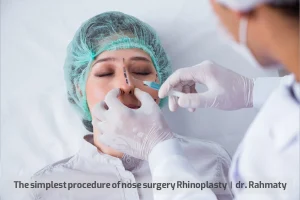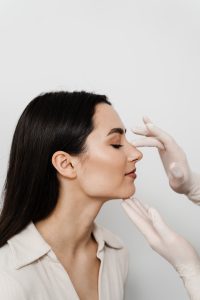The Simplest and Least Invasive Approach to Nose Surgery: Non-Surgical Rhinoplasty
Non-surgical rhinoplasty, also known as “liquid nose job” or “nose filler lift,” is one of the simplest and least invasive methods related to nose enhancement. This method appeals to many individuals seeking a pain-free and hassle-free nose correction with minimal post-procedure complications. Unlike traditional surgical rhinoplasty, this approach uses dermal fillers, such as hyaluronic acid-based products (e.g., Juvederm or Restylane), to temporarily reshape the nose.
Key Features of Non-Surgical Rhinoplasty as the Simplest Nose Procedure
- Minimally Invasive: Involves only injections, requiring no incisions or general anesthesia.
- Quick Process: Typically takes 15 to 30 minutes.
- Temporary Results: Effects last between 6 months to 2 years, depending on the type of filler.
- Reversible: If hyaluronic acid-based fillers are used, results can be reversed using an enzyme called hyaluronidase in case of dissatisfaction.
- Applications:
- Smoothing small bumps or irregularities.
- Enhancing the bridge or tip of the nose.
- Correcting minor asymmetries in nasal shape.
Limitations:
- Cannot reduce the size of the nose or address functional issues like breathing problems (e.g., deviated septum).
- Risks include bruising, swelling, and rare vascular complications.
What is Non-Surgical Rhinoplasty?
Non-surgical rhinoplasty is a cosmetic and minimally invasive procedure that uses injectable fillers, typically hyaluronic acid-based products (like Juvederm or Restylane), to temporarily alter the shape, structure, or appearance of the nose without surgery. The procedure is outpatient, allowing you to return home immediately after.
How the Procedure is Performed
Consultation:
- Discuss your goals with the doctor, who will evaluate the shape and structure of your nose.
- Any contraindications (e.g., allergies or skin issues) are assessed.
Preparation:
- The nasal area is cleaned, and a topical numbing cream may be applied for added comfort.
Injection:
- Small amounts of filler are injected into specific areas (e.g., nasal bridge, tip, or sides) to smooth irregularities, improve contour, or enhance symmetry.
Shaping:
- The doctor may gently massage the area to mold the filler into the desired shape.
Final Check:
- You can immediately see the results and provide feedback for adjustments if necessary.
Who is Suitable for This Procedure?
Non-surgical rhinoplasty is ideal for individuals who:
- Have minor aesthetic concerns about their nose, such as:
- Small bumps or depressions.
- A flat bridge (common among those seeking an improved side profile).
- Lack of definition in the tip or bridge.
- Desire temporary results before committing to surgery.
- Wish to avoid surgery and its associated risks or downtime.
Benefits and Drawbacks of Non-Surgical Rhinoplasty
Benefits:
- Minimally Invasive: No incisions or general anesthesia required.
- Quick: The entire procedure often takes less than 30 minutes.
- Reversible: Hyaluronic acid fillers can be dissolved with hyaluronidase if needed.
- Minimal Downtime: You can resume normal activities the same day.
- Immediate Results: Changes are visible right after the procedure.
Drawbacks:
- Temporary Nature: Results typically last 6 months to 2 years, depending on the filler used.
- Limitations: Cannot reduce nose size or address internal structural issues.
- Risks: Although rare, complications such as bruising, infection, or vascular problems (e.g., blood flow blockage) may occur.
- Recurring Costs: Due to the temporary nature, repeated treatments may be expensive over time.
Potential Risks
Although generally safe, non-surgical rhinoplasty carries some risks, including:
- Bruising and Swelling: Common but temporary.
- Vascular Issues: Incorrect filler placement may block blood flow, causing tissue damage.
- Infection: Rare but possible.
- Asymmetry: Uneven results if the filler is not injected properly.
Who Should Avoid This Procedure?
Non-surgical rhinoplasty may not be suitable for:
- Pregnant or breastfeeding women.
- Individuals with severe allergies to filler ingredients.
- Those with significant breathing issues or deviated septum (which require surgery).
- People seeking permanent results.
- Immediate Effects: The nose may feel slightly tender, with minor swelling or redness at the injection sites.
- Post-Procedure Care:
- Avoid touching or massaging the nose for 24 hours.
- Refrain from intense exercise, alcohol, and excessive heat (e.g., sauna) for 1–2 days.
- Follow-Up: Some patients may require touch-up sessions within a few weeks.
If you are considering this procedure or any other nose-related treatments, it is essential to consult with a qualified and experienced doctor to ensure safety and optimal results. You can book an appointment with Dr Benyamin Rahmati to explore non-surgical rhinoplasty options or other advanced rhinoplasty techniques using top-quality materials and equipment.
For more information about rhinoplasty, you can also explore related articles and stay informed.







